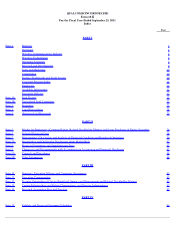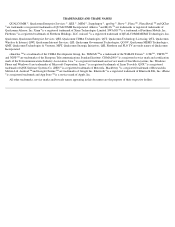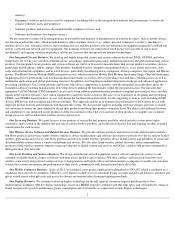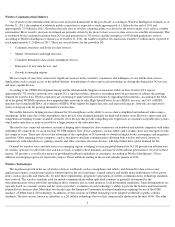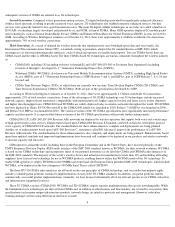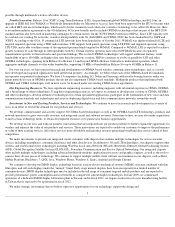Qualcomm 2011 Annual Report Download - page 14
Download and view the complete annual report
Please find page 14 of the 2011 Qualcomm annual report below. You can navigate through the pages in the report by either clicking on the pages listed below, or by using the keyword search tool below to find specific information within the annual report.
division markets and sells products through a sales force, partnerships and distributors based in the United States, Europe, Latin America, Asia
and Canada. Through September 2011 , we have shipped approximately 1,511,000 satellite- and terrestrial-based mobile information units.
Wireless transmissions and position tracking for satellite-based systems are provided by using leased transponders on commercially available
geostationary Earth orbit satellites. The terrestrial-based systems use wireless digital and analog terrestrial networks for messaging transmission
and the global positioning system constellation for position tracking. We generate revenues from sales of network products and terminals and
information and location-based service and license fees.
In the United States and Mexico, we manufacture mobile fleet management equipment, sell related software packages and provide ongoing
messaging and maintenance services. Message transmissions for operations in the United States are formatted and processed at our Network
Management and Data Center in San Diego, California, with a fully-redundant backup Network Management and Data Center located in Las
Vegas, Nevada.
Existing competitors of our QES division offering alternatives to our products are aggressively pricing their products and services and could
continue to do so in the future. Domestically, we face five key competitors to our satellite- and terrestrial-based mobile fleet management and
asset tracking products and services. Internationally, we face several key competitors in Europe and Mexico. These competitors are offering new
value-added products and services similar in many cases to our existing or developing technologies. Emergence of new competitors, particularly
those offering low-cost terrestrial-based products and satellite-based products, may impact margins and intensify competition in new regions.
Similarly, some original equipment manufacturers of trucks and truck components are beginning to offer built-in, on-board fleet management
and position location reporting systems that may impact our margins and intensify competition for existing and new customers.
Qualcomm Government Technologies (QGOV). The QGOV division provides development, hardware, analytical expertise and services
involving wireless communications technologies to United States government (USG) agencies. Based on the percentage of QGOV revenues to
our total consolidated revenues, the USG is not a major customer.
Firethorn. In fiscal 2011, Firethorn introduced a new product application trademarked as SWAGG, which is marketed on a standalone basis
directly to consumers. SWAGG’s core features include access to merchant loyalty accounts and gift card balances; purchase and gift of virtual
stored-value gift cards delivered via mobile devices; and access to relevant and targeted offers from participating merchants. Distribution of
SWAGG has been initially limited to certain smartphones, and content is sourced from merchants, primarily through open platforms. In addition
to SWAGG, Firethorn provides a single, secure, certified application embedded on select wireless devices, which enables financial institutions
and merchants to deliver branded services to consumers through the wireless devices.
Qualcomm Strategic Initiatives Segment (QSI). QSI makes strategic investments that we believe will open new opportunities for our
technologies, support the design and introduction of new products and services for voice and data communications or possess unique capabilities
or technology. Many of these strategic investments are in early-stage companies. QSI also holds wireless spectrum. As part of our strategic
investment activities, we intend to pursue various exit strategies at some point in the future.
Other Businesses.
Qualcomm MEMS Technologies (QMT). We continue to develop display technology for the full range of consumer-
targeted mobile products.
QMT’s IMOD display technology, based on a MEMS structure combined with thin film optics and sold under the “mirasol” brand, is expected
to provide performance, power consumption and cost benefits as compared to current display technologies. With the inclusion of color displays
in all types of mobile devices, including low-
end models, the cost of the display has become an even more significant factor in the overall cost of
the device. An IMOD display should cost less to manufacture than a comparable liquid crystal display because it requires fewer components and
processing steps, thus supporting advanced multimedia capabilities on all tiers of mobile devices.
Research and Development
The communications industry is characterized by rapid technological change, requiring a continuous effort to enhance existing products and
develop new products and technologies. Our research and development team has a demonstrated track record of innovation in voice and data
communication technologies. Our research and development expenditures in fiscal 2011 , 2010 and 2009 totaled approximately $3.0 billion,
$2.5 billion and $2.3 billion, respectively, and as a result, we continue to expand our intellectual property portfolio. Research and development
expenditures were primarily related to the development of integrated circuit products, next generation CDMA and OFDMA technologies and
other initiatives to support the acceleration of advanced wireless products and services, including lower cost devices, the integration of wireless
with consumer electronics and computing, the convergence of multiband, multimode, multinetwork products and technologies, third-party
operating systems and services platforms. The technologies supporting these initiatives may include CDMA2000 1X, 1xEV-DO, EV-DO
Revision A, EV-DO Revision B, 1x Advanced, WCDMA, HSDPA, HSUPA, HSPA+, TD-SCDMA and LTE. Research and development
expenditures were also incurred related to the development of mirasol display products using
9


